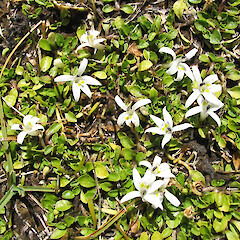Lobelia ionantha
Common name
hypsela
Synonyms
Hypsela rivalis E.Wimm.; Isotoma rivalis (E.Wimm.) Lammers
Family
Campanulaceae
Flora category
Vascular – Native
Endemic taxon
Yes
Endemic genus
No
Endemic family
No
Structural class
Herbs - Dicotyledons other than Composites
NVS code
The National Vegetation Survey (NVS) Databank is a physical archive and electronic databank containing records of over 94,000 vegetation survey plots - including data from over 19,000 permanent plots. NVS maintains a standard set of species code abbreviations that correspond to standard scientific plant names from the Ngä Tipu o Aotearoa - New Zealand Plants database.
LOBION
Chromosome number
2n = 14
Current conservation status
The conservation status of all known New Zealand vascular plant taxa at the rank of species and below were reassessed in 2017 using the New Zealand Threat Classification System (NZTCS) – more information about this can be found on the NZTCS website. This report includes a statistical summary and brief notes on changes since 2012 and replaces all previous NZTCS lists for vascular plants.
Please note, threat classifications are often suggested by authors when publications fall between NZTCS assessment periods – an interim threat classification status has not been assessed by the NZTCS panel.
- Conservation status of New Zealand indigenous vascular plants, 2017 . 2018. Peter J. de Lange, Jeremy R. Rolfe, John W. Barkla, Shannel P. Courtney, Paul D. Champion, Leon R. Perrie, Sarah M. Beadel, Kerry A. Ford, Ilse Breitwieser, Ines Schönberger, Rowan Hindmarsh-Walls, Peter B. Heenan and Kate Ladley. Department of Conservation. Source: NZTCS and licensed by DOC for reuse under the Creative Commons Attribution 4.0 International licence.
2017 | At Risk – Declining | Qualifiers: DP
Previous conservation statuses
2012 | At Risk – Declining | Qualifiers: DP
2009 | At Risk – Declining | Qualifiers: DP
2004 | Not Threatened
Distribution
Endemic. New Zealand: South Island (Marlborough, Canterbury, Otago, and Southland).
Habitat
Lowland to subalpine. A species of the margins of lake, tarn and ephemeral wetlands, stream banks, and seepages in tussock grassland, where it grows with other short turf and small herb species.
Wetland plant indicator status rating
Information derived from the revised national wetland plant list prepared to assist councils in delineating and monitoring wetlands (Clarkson et al., 2021 Manaaki Whenua – Landcare Research Contract Report LC3975 for Hawke’s Bay Regional Council). The national plant list categorises plants by the extent to which they are found in wetlands and not ‘drylands’. The indicator status ratings are OBL (obligate wetland), FACW (facultative wetland), FAC (facultative), FACU (facultative upland), and UPL (obligate upland). If you have suggestions for the Wetland Indicator Status Rating, please contact: [Enable JavaScript to view protected content]
OBL: Obligate Wetland
Almost always is a hydrophyte, rarely in uplands (non-wetlands).
Detailed description
Creeping, prostrate, usually glabrous herb; rooting at leaf nodes. Leaves alternate, upright to spreading; lamina 3.0–9.0 × 2.0–7.0 mm, , green, usually blotched purple-brown, orbicular, suborbicular, to broadly elliptic, often oblanceolate and oblong in shade glabrous to rarely hairy, hairs when present < 0.2 mm long and patent, midvein faint, lateral veins faint to obscure, margin with 5–7 prominent denticles or shallow teeth, apex obtuse to subacute; petiole 0.5–1.5 × 0.2–0.5 mm. Flowers hermaphrodite, axillary, solitary; peduncle 0.5–27.0 mm long, 0.4–0.6 mm wide, usually glabrous. Calyx with short tube adnate to ovary; lobes 5, 1.3–2.8 × 0.4–0.8 mm, green, narrow triangular to lanceolate, abaxial surface usually glabrous hairy, adaxial surface glabrous or occasionally sparsely hairy near apex; apex subacute and with conspicuous usually translucent tip. Corolla 8.0–12.0 mm diam. when open, white to pale blue, two green or yellow-green markings between the sinus of the front three corolla lobes, with conspicuous purple-violet blotches at the base of the three front corolla lobes; tube 3.5–6.0 mm long, 1.0–2.0 mm wide, fused, abaxial surface glabrous to sparsely hairy, adaxial surface sometimes sparsely hairy; lobes 5, 4.0–6.0 × 1.2–2.4 mm, narrow-lanceolate, recurved, abaxial surface glabrous to rarely sparsely hairy, abaxial surface glabrous, apex subacute. Filaments 4.0–7.5 mm long, 0.2–0.3 mm wide, fused below anthers, adnate from base to upper half of the corolla tube, white occasionally flushed pale blue in distal part, becoming translucent and flushed green toward proximal part. Anthers 1.2–1.6 mm long, united into a tube around style, purple-brown, curved over at top, with small central pore < 0.1 mm diam.; 2 awns and several hairs present at apex on lower anthers, awns 0.2–0.4 mm long, hairs < 0.2 mm long. Ovary 1.5–2.5 × 1.1–1.4 mm, green, glabrous to moderately hairy, apex obtuse. Style 5.0–8.0 mm long, 0.2–0.5 mm wide, white to pale green, exserted beyond anthers. Stigma bilobed, lobes 0.3–0.7 × 0.4–1.0 mm, pink, subtended by whorl of hairs. Capsule 2.5–5.0 × 1.4–2.5 mm, green, often flushed purple-brown; thin-walled, seeds visible through wall, indehiscent and without apical valves, disintegrating with age; apex crowned with persistent style base; base obtuse to slightly cuneate. Seed, 0.4–0.5 mm long; olive green semi-glossy, glabrous, broadly elliptic to obovate-oblong, slightly compressed and often squared with flattened faces.
Similar taxa
Differs from Lobelia carens Heenan and L. fatiscens Heenan by its usually glabrous stems, leaves, and flower parts, from L. carens by the large flowers that have purple blotches at the base of the lower three corolla lobes, and from L. fatiscens by its usually orbicular leaves, larger flowers, diploid (2n = 14) rather than tetraploid (2n = 28) chromosome number.
Flowering
October - April
Flower colours
Blue, White
Fruiting
November - June
Propagation technique
Easily grown from fresh seed and rooted pieces. An attractive ground cover for a damp sunny or semi-shaded site. An excellent pot plant.
Threats
Threatened because the wetland habitats it occupies have been or continue to be modified by changes in land use and naturalised plant species.
Etymology
lobelia: Named after Lobel, pioneer botanist
Attribution
Description modified from Heenan et al. (2008).
References and further reading
Heenan et al. 2008: Generic placement in Lobelia and revised taxonomy for New Zealand species previously in Hypsela and Isotoma (Lobeliaceae). New Zealand Journal of Botany 46: 87–100.













